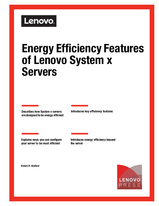Author
Published
24 Aug 2015Form Number
REDP5259PDF size
35 pages, 172 KBAbstract
Several years ago, little thought was given to how much power servers used. With plentiful energy resources and low electrical rates, server characteristics, such as low cost, high performance, and high reliability were considered more important than improving the power efficiency of servers. That all changed when the price of electricity began to rise dramatically during 2004 and 2005. From 2004 to 2008, the price jumped by another 30%. Even after 2008, the dramatic jump leveled off but did not drop back to the previous levels. It seems that higher electrical rates are here to stay. This dramatic increase in a short period of time sparked the need of data center managers to develop more efficient computing solutions.
Designing high power efficiency into a server requires a balanced approach. If peak power efficiency were the only goal, a server can be designed with considerable efficiency. However, the server would be large, have slow absolute performance and high latency, little expansion capability, and be expensive. It also would have few reliability, availability, and serviceability (RAS) features. Designing a server that is wanted requires the consideration of efficiency, performance, capability, and cost.
This paper is for clients who want understand energy efficiency and the ways that Lenovo System x servers use components and features to maximize energy efficiency.
Tip: For ThinkSystem servers, see the paper Energy Efficiency Features of Lenovo ThinkSystem Servers, https://lenovopress.com/lp0780-energy-efficiency-features-of-lenovo-thinksystem-servers
Related product families
Product families related to this document are the following:

